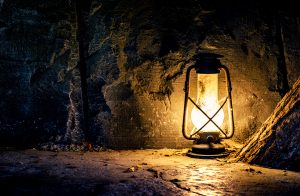 Mining, and the use of metals and minerals within the earth, has moved societies and civilizations since the beginning of time. After all, we define eras by the metal that molded them: Bronze Age, Iron Age, etc. However, the process of extracting those metals from the earth is a history that isn’t often told. Fraught with the risk of explosions, collapses, and disease, mining has always been a dangerous pursuit. While the progress of mining technology and safety is slow, it’s also full of amazing ingenuity and resourcefulness. For example, the Davy safety lamp.
Mining, and the use of metals and minerals within the earth, has moved societies and civilizations since the beginning of time. After all, we define eras by the metal that molded them: Bronze Age, Iron Age, etc. However, the process of extracting those metals from the earth is a history that isn’t often told. Fraught with the risk of explosions, collapses, and disease, mining has always been a dangerous pursuit. While the progress of mining technology and safety is slow, it’s also full of amazing ingenuity and resourcefulness. For example, the Davy safety lamp.
As you well know, one of the biggest dangers of mining is the air quality. It’s risky enough today, but imagine how scary it would be before modern detection technology, back when your only source of light down in a mine was a naked flame.
Firedamp Was Every Miner’s Nightmare
“Firedamp” was the name given in England to dangerous underground gasses that could cause explosions. For the most part, firedamp was composed of methane, which would gather in pockets in the coal and rock. When it came in contact with a lamp or torch, the whole area would go up in flame. Though danger was high, the demand for coal to fuel the Industrial Revolution of the late 1700’s was higher. Many mines would send in a “firefighter” at the beginning of a shift–an individual dressed in water-soaked clothing with a flame at the end of a long pole–to clear out any firedamp that was lying in wait. Obviously, it wasn’t an ideal solution. The early 1800’s saw a rush of scientists and engineers turning their efforts to solving this problem.
In 1813 a Temporary Solution Was Discovered
After a cataclysmic explosion in 1812 in Northeast England which took the lives of 92 miners, a local Rector decided to take decisive action. John Buddle enlisted the help of Humphrey Davy, President of the Royal Society, to create a safer method of lighting in the mines. After some experimentation, Davy learned something significant: although the firedamp gas could pass through wire mesh, the flame didn’t! In the presence of firedamp, the flame would turn blue, but the heat of the fire would be absorbed by the wire, so the flame couldn’t light gases outside of the lamp. The wire mesh allowed enough light to pass through in order to work effectively, but minimized the risk of explosion.
In 1816, the lamp quickly went into mass production, reducing the amount of fire-related accidents in mines significantly. It helped to further fuel the coal production to move the Industrial Revolution forward and establish Britain at the forefront of development. Of course, the lamp wasn’t perfect. Small holes in the mesh would bring back the risk, and mine owners and developers still ignored solutions like proper ventilation fans that would greatly reduce the risk to workers.
Davy Lamps Were a Simple Solution We Still Use Today
It wasn’t until electric lights were widely available in the late 1800’s that Davy lamps went out of mass circulation. However, the design is still used to test for presence of firedamp in UK mines. A variation on the design has been used for the Olympic torch in the games in Sydney, Athens, and Beijing.


Leave a Comment